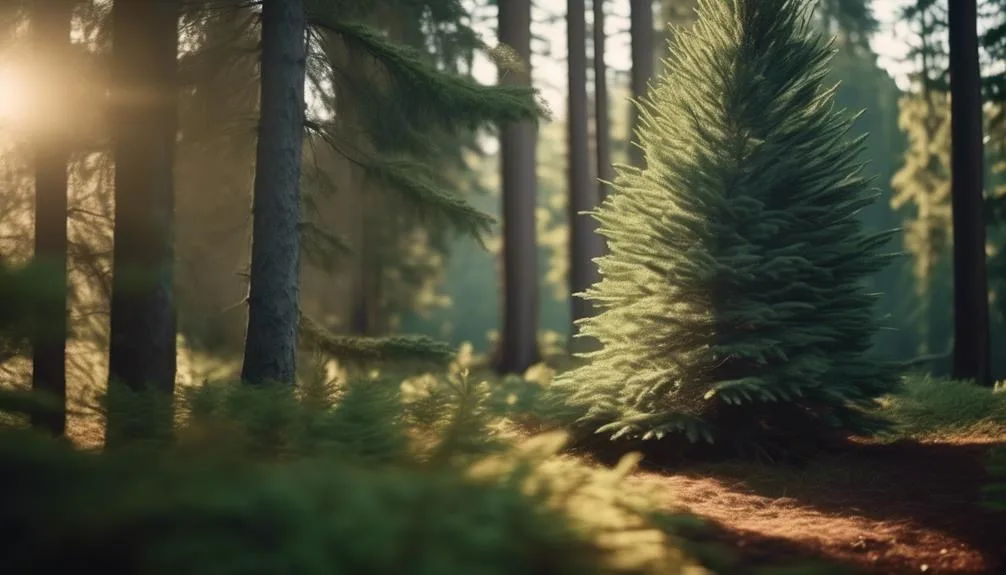The history and symbolism of spruce trees hold a fascinating significance across different cultures and belief systems. From ancient traditions to modern conservation, these evergreens have made a lasting impact on art, literature, and spirituality.
Exploring their rich past reveals a world where nature and symbolism are closely intertwined, offering a glimpse into the deep connections between humanity and the natural world.
Ancient Roots of Spruce Trees
Explore the ancient roots of spruce trees, tracing back through centuries of history and symbolism.
Spruce trees have developed impressive root systems to withstand harsh environmental conditions, showcasing their exceptional environmental adaptation. These resilient roots delve deep into the earth, providing stability and nourishment to the towering spruce.
Ancient traditions and folklore often depict spruce trees as symbols of protection and resilience, revered for their ability to thrive in diverse landscapes. From the dense forests of North America to the rugged terrain of the Alps, spruce trees have adapted to various climates, solidifying their significance in cultural narratives.
Their enduring presence in folklore and mythology reflects the profound impact spruce trees have had on human civilization, embodying strength and endurance in the face of adversity.
Cultural Significance and Mythology
With its deep roots and resilience, the spruce tree has woven itself into cultural significance and mythology, embodying strength and endurance in the face of adversity across diverse landscapes and traditions.
Across various mythological beliefs, the spruce tree is often associated with protection, wisdom, and eternal life, symbolizing the interconnectedness of the natural world and humanity.
In cultural practices, the spruce tree holds a revered position, often being used in ceremonies and rituals to signify renewal, purification, and resilience. In some traditions, the evergreen nature of the spruce tree represents immortality and hope, serving as a reminder of life's continuity even in the harshest of conditions.
Its presence in folklore and legends further solidifies its role as a symbol of fortitude and everlasting endurance.
Symbolism in Art and Literature
In art and literature, the symbolism of the spruce tree often conveys themes of resilience, hope, and the enduring connection between nature and humanity.
Artists and writers have found artistic inspiration in the sturdy and evergreen nature of the spruce, using it to represent strength and perseverance in the face of adversity.
In paintings, the towering presence of the spruce tree can evoke a sense of resilience and stability, while its deep green color symbolizes vitality and hope.
In literature, the spruce tree has been used in various literary references to signify endurance and the unbreakable bond between humans and the natural world.
From ancient folklore to modern storytelling, the spruce tree continues to be a powerful symbol, enriching artistic and literary expressions with its profound significance.
Spiritual Connections and Rituals
Spiritually, engaging with spruce trees can be a deeply meaningful experience, as they've been used in various rituals and traditions across different cultures for centuries.
- Nature Worship: Many indigenous cultures revere spruce trees, incorporating them into nature worship and spiritual practices. These trees are seen as sacred and are often used in rituals that honor the natural world and its interconnectedness.
- Sacred Ceremonies: Spruce trees play a significant role in sacred ceremonies, symbolizing resilience, wisdom, and protection. They're often central to rituals that mark important life events or seasonal transitions.
- Tree Symbolism: In various belief systems, the spruce tree symbolizes strength, longevity, and the divine connection to the earth. It's revered for its ability to thrive in harsh conditions, representing endurance and spiritual growth.
Modern-Day Impact and Conservation
Embedded in the cultural and spiritual fabric of societies, the enduring significance of spruce trees extends to their modern-day impact and the imperative need for conservation efforts. Conservation efforts are crucial to safeguarding the environmental impact of these majestic trees.
As carbon sinks, spruce trees play a vital role in mitigating climate change by absorbing carbon dioxide from the atmosphere. Their dense foliage provides habitats for various species, contributing to biodiversity. However, modern-day activities such as deforestation and urbanization pose significant threats to spruce tree populations.
Conservation efforts, including reforestation initiatives and sustainable logging practices, are essential to preserve these vital ecosystems. Additionally, raising awareness about the importance of spruce trees in maintaining ecological balance is key to garnering support for their conservation.
It's imperative to take action now to ensure the continued existence of spruce trees for future generations.
Conclusion
As we admire the grandeur of spruce trees, let's honor their deep-rooted history, cultural significance, and enduring impact on our world.
Let's continue to cherish and protect these remarkable trees, recognizing their timeless value and the legacy we can pass on to future generations.
How can we each contribute to the preservation of these vital symbols of nature?

My interest in trees started when I first saw the giant sequoias in Yosemite.
I was a teenager then, and I remember thinking, “I need to learn more about this.”
That moment stuck with me.
A few years later, I went on to study forestry at Michigan Tech.
Since graduating, I’ve worked in a mix of hands-on tree care and community education.
I’ve spent over ten years helping people understand how to plant, maintain, and protect the trees in their neighborhoods.
I don’t see trees as just part of the landscape.
They are living things that make a real difference in our daily lives.
